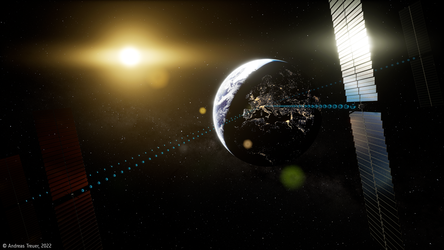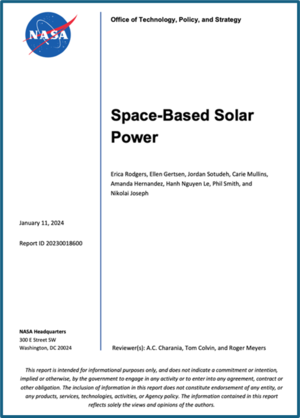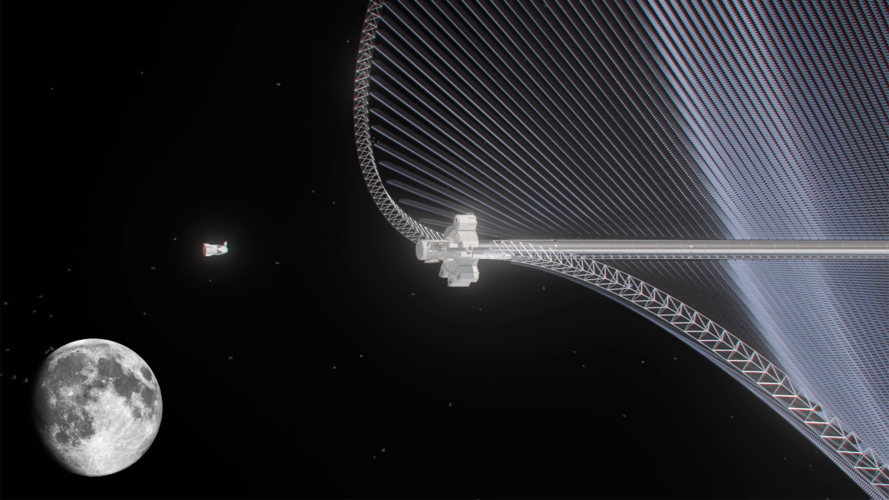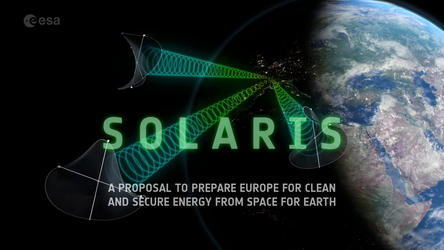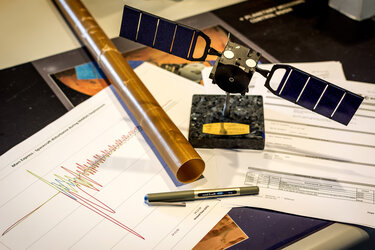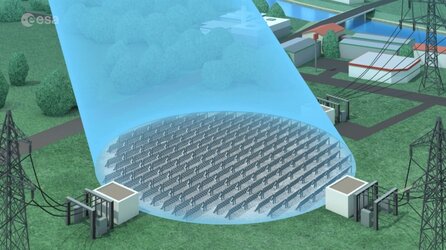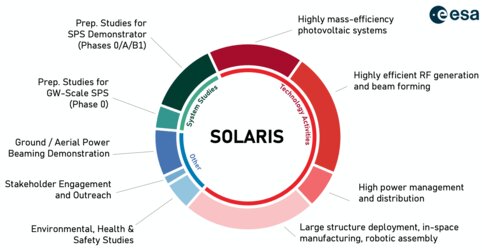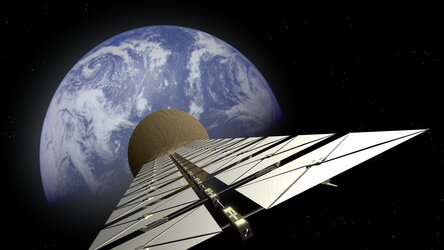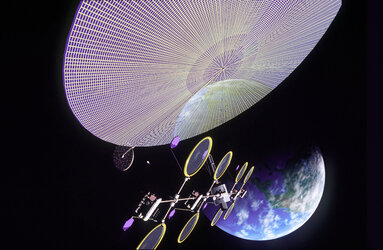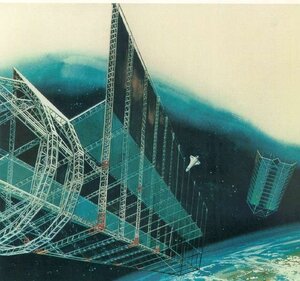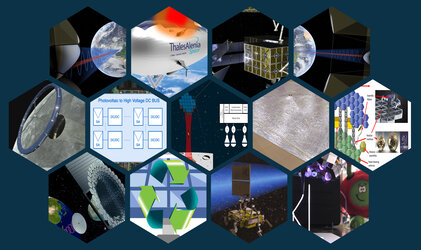ESA-supported technology developments
The concept of Space Based Solar Power is well established, but the required technologies are still in their early stages of development, so in 2020 ESA’s future-oriented Discovery programme issued a call for ideas through the Agency’s Open Space Innovation Platform.
Space Based Solar Power is an extremely interdisciplinary topic, involving a wide range of technologies at various stages of development. So, with this call, ESA addressed a variety of organisations to gather around a common theme. The aim was to answer the following question in as much detail as possible: how do you convert a large amount of solar energy into a useful form and beam it down to Earth or another planetary surface, as efficiently as possible?
These activities have all been launched to explore a diverse range of Space Based Solar Power technologies, including how to more efficiently collect sunlight and how to safely transmit this power to Earth, as well as how to manufacture and assemble these huge solar power satellites, control them and keep them in the right location.
The full list of projects is as follows:
• SPS Station Keeping Using Solar Radiation Pressure for Propulsion (Emerald Telecommunications)
To transmit uninterrupted power to a receiving station on the ground, a solar power satellite may need to include a propulsion system to counteract environmental forces that tend to perturb its orbit. This study will investigate a new method of 'station keeping' – using solar radiation pressure (the propulsion technique used by solar sails) to create the thrust forces needed to keep a solar power satellite in position.
• The interaction of structural dynamics with the orbital mechanics of Solar Power Satellites (Frazer-Nash)
Considering that solar power satellites are likely to be large, sparse and flexible structures, they are likely to deform whilst in orbit. This study will investigate the relationship between orbit mechanics and the structural properties of solar power satellites (SPS), leading to the development of design rules for SPS structures to minimise any deformation effect.
• GE⊕ Lunar Power Station (Astrostrom)
The Greater Earth Lunar Power Station (GE⊕-LPS) is a concept for a habitable space station in lunar orbit that is designed to provide solar energy for lunar operations. It would use materials from the Moon to construct elements of the solar power satellite using a lunar-based automated manufacturing process connected to a mass driver system for transport into a lunar orbit.
• An End-of-Life Strategy for Solar Power Satellites (Frazer-Nash)
This study will investigate the degradation mechanisms that lead to an SPS reaching the end of its useful life and determine the likely state of the constituent modules. Using this information, the researchers will consider how the modules or materials should be handled. They will also determine how the SPS could be designed to make their end of life more sustainable, for instance by recycling or reusing some of their components.
• Skybeam: Assembly of a Space Solar Power system with European Technologies (Space Applications Services)
This study will take a new look at the assembly of an SBSP station based on strategic technologies being developed in Europe. The concept foresees multiple multi-axis robots that create the vast (kilometre-scale) structural elements of solar power satellites by mounting standardised construction elements together.
• Receiv'Air – Bypassing of atmospheric attenuation for SPS with airborne receiver (Thales Alenia Space)
Solar power satellites will convert solar energy and beam it down to Earth. The lower the frequency of the Earth-bound beam, the larger the receiver needs to be. But the higher the frequency, the more power that will be lost during its journey through the atmosphere. This study would look into using an airship to receive a high frequency beam at a high altitude.
• Tiled Energy Focus with Solar Concentrators (Instituto de Telecomunicacoes – University of Aveiro)
This early technology development project aims to develop a solar power satellite tile that can be expanded as needed to create a massive structure that would convert solar energy and transmit power to stations on the surface of the Moon. It would supply continuous power to lunar stations, even when they do not have direct sunlight.
• Development of Millimetre Waves Wireless Power Transfer (WPT) System for Lunar Rover Explorations (Sirin Orbital Systems)
This early technology development project will focus on developing technology for the wireless transfer of power via microwaves or millimetre waves. SBSP for supplying clean energy to Earth is still a relatively long-term goal, so this project will focus on the intermediate goal of supplying energy to the Moon.
• Disruptive PV power array technology to enable economic viability of SPS (CSEM)
Currently, photovoltaic arrays for solar power satellites are too expensive and far too heavy for competitive and economically viable solar power satellites. The aim of this early technology development project is to merge two established space technology materials and processes into one cheaper and lighter photovoltaic array architecture.
• Photo-irradiation annealing of radiation-induced degradation of multijunction solar cells for space-based power plants (Photonicity)
To reduce the cost of SBSP, maximising the lifetime of the solar cells is vital. Today, multijunction solar cells on Earth have a lifetime of 25–30 years. This early technology development project aims to develop a method to recover solar cells that have been degraded by radiation. Fixing these cells in orbit could significantly increase the lifetime of a solar power satellite.
• In-space manufacturing of large structures by direct extrusion of UV-curing polymer (Munich University of Applied Sciences)
Read more about this public idea in OSIP
• CORES – COllaborative Recycling of End-of-life SPS (University of Strathclyde)
The build-up of satellites and space debris in orbit around Earth threatens everything from space operations to ground-based astronomy. How can we ensure that solar power satellites don't add to the problem? This co-funded research project will study collaborative robotics solutions to dismantle, replenish and remanufacture large space infrastructures.
• Solar Array to High Voltage Power Bus: Power Conversion Techniques (Miguel Hernández University of Elche)
Solar arrays are currently limited to a few hundred volts. This is not nearly enough for solar power satellites, which would require significantly higher voltages. This co-funded research project will focus on recent trends in terrestrial high voltage photovoltaic power conversion as a starting point to answer the question: what are the most effective high voltage photovoltaic power conversion techniques for solar power satellites and how can they benefit current satellite power systems?















 Germany
Germany
 Austria
Austria
 Belgium
Belgium
 Denmark
Denmark
 Spain
Spain
 Estonia
Estonia
 Finland
Finland
 France
France
 Greece
Greece
 Hungary
Hungary
 Ireland
Ireland
 Italy
Italy
 Luxembourg
Luxembourg
 Norway
Norway
 The Netherlands
The Netherlands
 Poland
Poland
 Portugal
Portugal
 Czechia
Czechia
 Romania
Romania
 United Kingdom
United Kingdom
 Slovenia
Slovenia
 Sweden
Sweden
 Switzerland
Switzerland



























